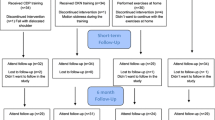Abstract
Vestibular rehabilitation has been found to be effective and safe in patients with instability. There is insufficient evidence, however, for distinguishing between the efficacies of different rehabilitation techniques. The objective of this study is to verify whether there are differences between two instrumental vestibular rehabilitation techniques, computerised dynamic posturography (CDP) and optokinetic stimulation (OKN), in order to establish the optimal strategy for each patient. We conducted a prospective, comparative study of the two techniques (CDP and OKN) in patients with instability due to chronic unilateral peripheral vestibular disorder. We randomly included 12 patients in each group, performing the evaluation with the Dizziness Handicap Inventory and the CDP with the sensorial organisation test (SOT), rhythmic weight shift and limits of stability (LOS). We found a statistically significant improvement in both groups in average balance score according to the SOT. In the OKN group, however, improvement was greater in visual preference. The CDP group showed greater benefits in the visual and vestibular input and LOS. Patients with poor vestibular and visual input or with reduced LOS will benefit more from an exercise protocol with CDP. Patients with poor visual preference, however, are ideal candidates for rehabilitation with OKN.

Similar content being viewed by others
References
Santos S, Soto A, Rossi M, Elhendi W, Labella T (2007) Tratamiento rehabilitador de los trastornos del equilibrio. Diseño de un protocolo general con la posturografía dinámica computerizada. An Otorrinolaringol Ibero Am 34(5):465–484
Hillier SL, Hollohan V (2007) Vestibular rehabilitation for unilateral peripheral vestibular dysfunction. Cochrane Database Syst Rev 4:CD005397
Herdman SJ, Hall CD, Schubert MC, Das VE, Tusa RJ (2007) Recovery of dynamic visual acuity in bilateral vestibular hypofunction. Arch Otolaryngol Head Neck Surg 133:383–389
Kao CL, Chen LK, Chern CM, Hsu LC, Chen CC, Hwang SJ (2010) Rehabilitation outcome in home-based versus supervised exercise programs for chronically dizzy patients. Arch Gerontol Geriatr 51(3):264–267
Rossi-Izquierdo M, Soto-Varela A, Santos-Pérez S, Sesar-Ignacio A, Labella Caballero T (2009) Vestibular rehabilitation with computerized dynamic posturography in patients with Parkinson’s disease: improving balance impairment. Disabil Rehabil 31(23):1907–1916
Brown KE, Whitney SL, Marchetti GF, Wrisley DM, Furman JM (2006) Physical therapy for central vestibular dysfunction. Arch Phys Med Rehabil 87:76–81
Burton MJ, Monsell EM, Rosenfeld RM (2008) Extracts from The Cochrane Library: vestibular rehabilitation for unilateral peripheral vestibular dysfunction (review). Otolaryngol Head Neck Surg 138(4):415–417
Jongkees LBW, Maas JPM, Philipszoon AJ (1962) Clinical nystagmography. A detailed study of electronystagmography in 341 patients with vertigo. Pract Otorhinolaryng 24:65–93
Bartual Pastor J (1998) Pruebas calóricas. In: Bartual Pastor J, Pérez Fernández N (eds) El sistema vestibular y sus alteraciones. Masson, Barcelona, pp 221–237
Pérez N, Garmendia I, Martín E, García-Tapia R (2000) Cultural adaptation of 2 questionnaires for health measurement in patients with vertigo. Acta Otorrinolaringol Esp 51(7):572–580
Nashner LM (2001) Computerize dynamic posturography. In: Goebel JA (ed) Practical management of the dizzy patient. Lippincott Williams & Wilkins, Philadelphia, pp 143–170
Rossi Izquierdo M, Soto Varela A, Santos Pérez S, Labella Caballero L (2008) Análise prospectivo dos resultados da reabilitação vestibular mediante posturografía dinâmica computorizada em pacientes com instabilidade. Clin Inves Otorri 2(1):12–16
Vitte E, Semont A, Berthoz A (1994) Repeated optokinetic stimulation in conditions of active standing facilitates recovery from vestibular deficits. Exp Brain Res 102(1):141–148
Black FO, Angel CR, Pesznecker SC, Gianna C (2000) Outcome analysis of individualized vestibular rehabilitation protocols. Am J Otol 21:543–551
Wrisley DM, Stephens MJ, Mosley S, Wojnowski A, Duffy J, Burkard R (2007) Learning effects of repetitive administrations of the sensory organization test in healthy young adults. Arch Phys Med Rehabil 88(8):1049–1054
Perez N, Martin E, Garcia-Tapia R (2003) Dizziness: relating the severity of vertigo to the degree of handicap by measuring vestibular impairment. Otolaryngol Head Neck Surg 128(3):372–381
Whitney SL, Wrisley DM, Brown KE, Furman JM (2004) Is perception of handicap related to functional performance in persons with vestibular dysfunction? Otol Neurotol 25(2):139–143
Bronsteim AM, Vision, vértigo (2004) Some visual aspects of vestibular disorders. J Neurol 251:381–387
Shepard NT, Telian SA (1995) Programmatic vestibular rehabilitation. Otolaryngol Head Neck Surg 112:173–182
Conflict of interest
The authors report no conflicts of interest. The authors alone are responsible for the content and writing of the paper.
Author information
Authors and Affiliations
Corresponding author
Rights and permissions
About this article
Cite this article
Rossi-Izquierdo, M., Santos-Pérez, S. & Soto-Varela, A. What is the most effective vestibular rehabilitation technique in patients with unilateral peripheral vestibular disorders?. Eur Arch Otorhinolaryngol 268, 1569–1574 (2011). https://doi.org/10.1007/s00405-011-1532-z
Received:
Accepted:
Published:
Issue Date:
DOI: https://doi.org/10.1007/s00405-011-1532-z




